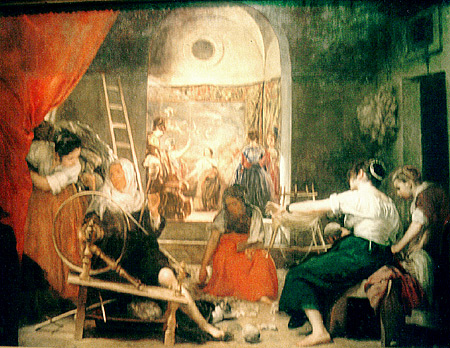|
Minerva et Arachnē
Ōlim puella, nōmine Arachnē, in Lydiā habitat. Parentēs nūllam pecūniam habent. Puella dīligenter labōrat et multās tēlās texit. Tēlae sunt pulchrae. Multī spectātōrēs igitur veniunt et puellam labōrantem cōnspiciunt. Omnēs Arachnēn laudant et, "Arachnē," clāmant, "nōn puella, nōn mortālis, sed dea est quod tēlās pulchrās texit." Arrogantia Minervam vextat quod Minerva dea bellī et dea artis est. Dī superiōrēs sunt, sed Arachnē, "Ego," inquit, "quoque dea sum, quod tēlās optimās texō." Minerva igitur ad terram venit.
Minerva Arachnēn vīsitat et, "Deī," inquit, "sunt superiōrēs. Necesse est mortālibus humilibus esse." Arachnē tament clāmat, "Minimē!" Deinde Minerva clāmat, "Ego sum dea Minerva. Nōs tēlās teximus. Mea tēla superior est." Nunc Arachnē et Minerva duās tēlās texunt. In tēlā Minervae est pictūra deōrum quī hominēs saepe adiuvant. In Arachnēs tēlā quoque est pictūra deōrum. In pictūrā tamen deī hominēs vexant. Minerva īrāta est ubi tēlam Arachnēs videt. Arachnē sollicita Minervam timet et mox mortua est. Minerva puellam mortuam salūtat, "Nunc es arānea et semper in terrā, agrīs, vīllīs, et arboribus tēlās texis."

Diego Velázquez, The Spinners (The Fable of Arachne)
courtesy of VRoma
(NOTE: You may find all the forms of the irregular Latin noun deus available online.
Find forms of deus and other irregular Latin nouns online.)
|
|